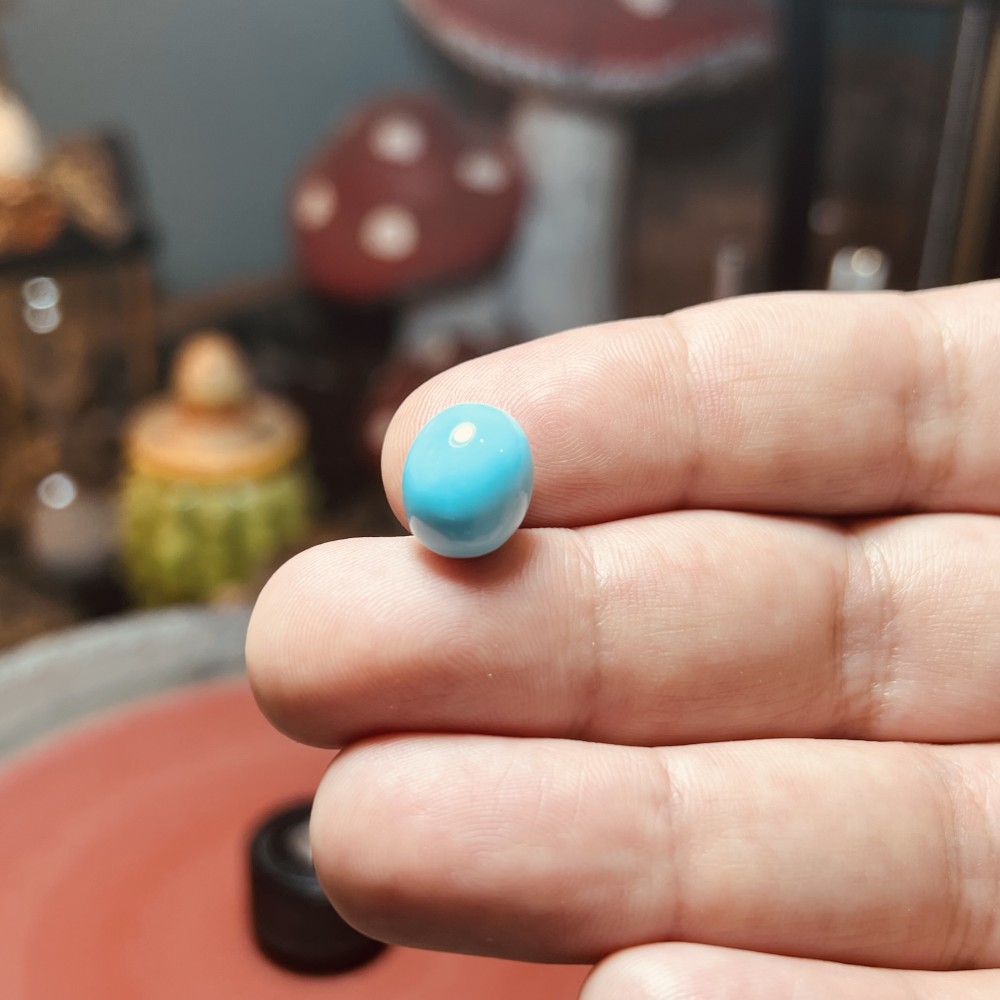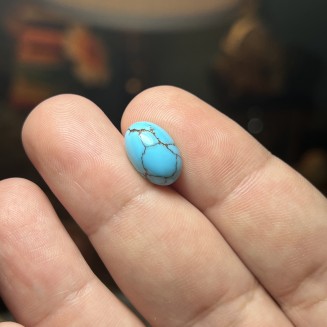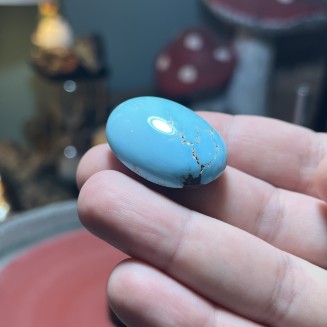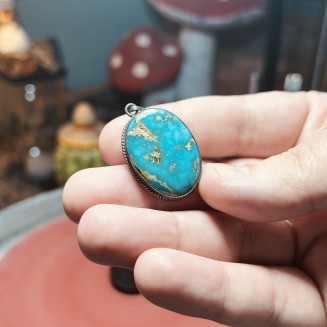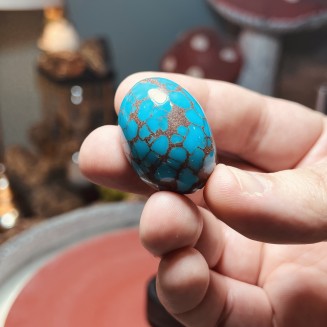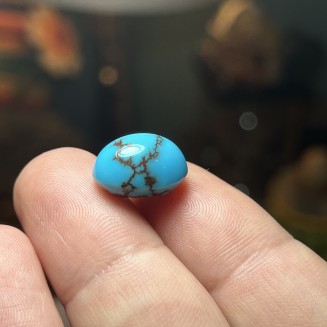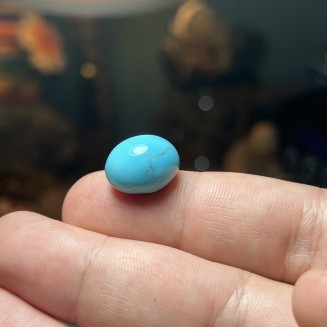Iranian Turquoise from Neyshabur old stock- old layers Stabalized only - weight 1.70 Grams
 Privacy Policy & Term of use:
Privacy Policy & Term of use:
We care about your privacy .. Read more
 Delivery:
Delivery:
We ship via express shipping in 3 business days
 Shipping & Returns:
Shipping & Returns:
We make sure to satisfy our customer .. Read more
1. Is turquoise a real gemstone?
Yes. Turquoise is a naturally occurring gemstone formed from hydrated copper and aluminum phosphate. It’s one of the oldest known gemstones, prized for its vivid blue to green hues and cultural significance across civilizations.
2. Where does the best turquoise come from?
The most valuable turquoise historically comes from Neyshabur, Iran, known for its intense sky-blue color. Other notable sources include the Sleeping Beauty Mine in Arizona, USA, and mines in China, Mexico, Egypt, Armenia, Africa and many more countries
3. Why does turquoise change color over time?
Natural turquoise is porous and can absorb oils, sweat, moisture, and chemicals. These interactions may cause the stone to shift in tone—often becoming more greenish. This is normal and part of its organic character
4. What does “stabilized turquoise” mean?
Stabilized turquoise has been treated—usually with clear resin—to fill pores and fractures. This makes it harder, more durable, and less prone to discoloration. It does not mean the stone is fake; it’s a protective enhancement, they also stabilizing it using super glue, acrylic, bee wax, bottom stabilizing only and many more techniques
5. Is stabilized turquoise less valuable?
Not necessarily. While untreated “gem-grade” turquoise is rare and highly prized, stabilized turquoise is still genuine and often preferred for jewelry due to its durability and consistent appearance.
6. Can turquoise be dyed or reconstituted?
Yes. Some low-grade turquoise is dyed to enhance its color or reconstituted by compressing turquoise powder with resin. These treatments are less valuable and should always be disclosed to buyers.
Important Note on Iranian Turquoise: While Iran—especially Neyshabur—is historically known for high-quality turquoise, current production is extremely limited. In recent years, dyed turquoise has been widely circulated without proper disclosure. Many sellers now source rough material from other countries and falsely claim it originates from Iran.
Iranian turquoise is not sold directly to customers. It is distributed only through official auctions, and quantities are very low. If you're buying turquoise labeled as "Iranian," be cautious—especially if the source is unknown or unverifiable.
For more information, you can always refer to visit our Instagram for real-time updates and transparency at @ajalkhabbaz you will be in direct contact with me on live stream and you can ask me whatever questions in your mind.
7. How Do I Care for Turquoise Jewelry?
-
Avoid exposure to perfumes, lotions, and cleaning products
-
Remove before swimming or bathing
-
Store in a dry, padded box away from direct sunlight
-
Clean gently with a soft cloth—never use ultrasonic cleaners or harsh chemicals
-
Or simply wear it comfortably and let nature take its course
Turquoise is a delicate stone—it responds to its environment and requires mindful care. Whether you choose to preserve its original color or embrace its natural evolution, proper handling ensures it remains beautiful and meaningful for years to come.
8. How Can I Tell If My Turquoise Is Real?
-
Genuine turquoise typically has a waxy to matte luster and may display natural matrix patterns (veins or webbing).
-
Stabilized turquoise often appears more polished and uniform in color and texture.
-
Professional gemological testing is the most reliable method for verification, especially when distinguishing between natural, stabilized, dyed, or reconstituted material.
Workshop Insight: Over the years, I’ve learned that stabilized turquoise reveals itself during the shaping process. When cabbing or faceting, different stabilization methods release distinct smells or produce bubbles under the machine. For example:
-
Resin emits a mild chemical scent
-
Super glue has a sharp, acrid smell
-
Acrylic gives off a synthetic plastic-like odor
Each technique has its own signature, but one stands out: the old plastic stabilization method. This outdated technique uses pure plastic chemicals, and when you begin shaping the stone, it releases an extremely intense, unmistakable smell that fills the workshop and can even cause discomfort.
We do not work with or accept stones treated using this method. If you encounter this reaction, it’s a strong indicator of low-grade or improperly stabilized turquoise—often misrepresented in the market.
For trustworthy sourcing and transparent treatment disclosure, feel free to explore our verified listings or reach out via Instagram for real-time updates and guidance.
👉 So, stabilizing turquoise is essentially a protective enhancement process, ensuring the stone is durable enough for jewelry without drastically altering its natural beauty and it protect the color of the turquoise forever.
Viewed products
-
-
-
-
Iranian Neyshabur Turquoise...
KWD245.000Note on Stabilization and Color Behavior
Stabilizing turquoise is a widely practiced technique used to enhance the stone’s durability and resistance to moisture. This process typically.
-
Iranian Neyshabur Turquoise...
KWD195.000Note on Stabilization and Color Behavior
Stabilizing turquoise is a widely practiced technique used to enhance the stone’s durability and resistance to moisture. This process typically.
-
Iranian Neyshabur Turquoise...
KWD275.000Note on Stabilization and Color Behavior
Stabilizing turquoise is a widely practiced technique used to enhance the stone’s durability and resistance to moisture. This process typically.


